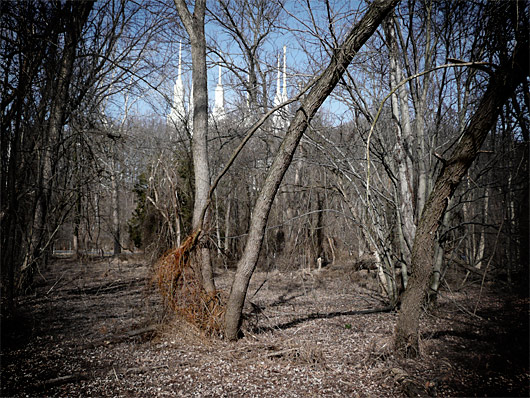February 22, 2009
On Forming a More Perfect Union: Art and Discourse Chat

Trees with Mormon Temple, 2009, ©Jeff Gates. Click on image for larger view. Yesterday, as I was driving the DC Beltway I suddenly saw the spires of the Mormon Temple above the leafless branches of Rock Creek Park. With no other man-made structures around, these steeples have always reminded me of the Morlocks’ towers rising above the growth of 802,701 A.D. in George Pal’s 1960 adaptation of H.G. Wells’ The Time Machine.
I’d always wanted to make a photo that evoked this feeling. And this clear winter day was a perfect time to do so. Bringing the image back to my computer I wanted to enhance the primeval feeling of the woods with the distant man-made construction. I created a slight vignette around the center of the image and reduced the color in the woods, reminiscent of 19th century photographs. I left a bit of color in the center branches at the foot of the tree to draw your eye in.
My latest hobby is photography, which is pretty ironic since I used to teach the subject and considered myself a fine art photographer a few years back. Using that word to describe my interest isn’t really too much of a stretch. Merriam-Webster defines it as “a pursuit outside one’s regular occupation engaged in especially for relaxation” and Word Net says it means “a spare time activity.” The word amateur has come to mean “less than professional.” But its original meaning was “lover of.” All aptly describe photography’s place in my life these days.
With a full-time job and a fuller-time family, it’s hard to fit in much more except for the occasional couch potato TV and Netflix sessions. Yet, the enjoyment I get from not only taking the photographs, but the post-visualization of the final image (that is, the after-the-fact manipulation of the photo to elicit just the right feeling) is worth my less-than-ample free time. And, more over, getting it out there —posting it on the Net and connecting with viewers— actually gets back to my original interest in photography. I love both making images and talking about them. I really enjoy the interaction.
When I was a teenager I had pen pals all over the world. From Japan to Czechoslovakia I looked forward to hearing about other people’s lives. In 1992 I had a one person exhibition of my work at the Baltimore Museum of Art. Every day I’d go over to the museum and listen to people comment to their friends as they looked at my photographs. And every once in a while I’d reveal myself, engaging them as they talked. I was never the stereotypical artiste, sequestered in his studio, unable and uninterested in engaging the public. Back when I was teaching art and photography many students would often take on this stereotype as their own: “my art should speak for itself: if you don’t get it it’s not my job to clue you in.” This always shocked me for I always felt just the opposite. I wanted to share and talk about what I was doing. And the best part was when a viewer would interpret my work in a way I’d never thought of.
In 1988 I founded ArtFBI (Artists for a Better Image) to study stereotypes of artists in contemporary culture. I wanted to see how this old artist paradigm would mesh within the burgeoning post-modern one. Sherrie Levine shocked the art world in 1979 with her series After Walker Evans, a direct reproduction of photographer Walker Evan’s work with her name as the artist. It was no longer just about the sanctity of the art object. It was about the discourse generated by the process of making art and its function in society. Flickr and other social media platforms like Twitter are updated versions of my younger interests. (And, in searching out online examples of Levine’s work to show you I came upon this Flickr photograph of Kristina Gibbs’ reproduction of Sherri Levine’s reproduction of Walker Evan’s photograph.)
I’ve been happily involved in this process for most of my life. In 1996 I wrote about New Roles for Artists in the Information Age. Back then I was a teacher. But now my day job at the Smithsonian American Art Museum has evolved to fit my interests perfectly. A good part of my work —actually it’s written into my performance plan— is to search the Net for interesting ways to place our artworks into new contexts and connect with new audiences.
While many of us at the Smithsonian have been working behind-the-social-media scenes for quite a while, suddenly it’s exploded into a flurry of activity. A few weeks back we invited a number of Net digerati to take part in Smithsonian 2.0, a discussion about moving all the Smithsonian’s interesting “stuff” out of our nation’s attic and onto as many networks as we can. This week the American Art Museum is devoting an entire day with all its staff to discuss this. Our aim: to get it out “there” for pleasure, discussion, and for you to use as you see fit. This is no small task for a museum complex born and, in many ways, still in the 19th century.
So, it’s not surprising that I’m using what little free time I have to continue doing what I’ve been doing for years: constructing images about our lives and introducing myself to you to engage in some chat.
Maybe this is more than just a hobby.
View Most Recent Story![]() :::
:::![]() Notify me when there's a new missive!
Notify me when there's a new missive!


 ShareThis
ShareThis